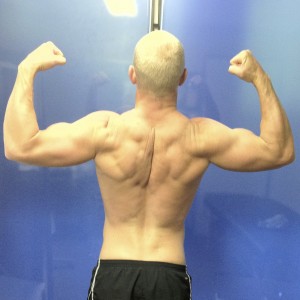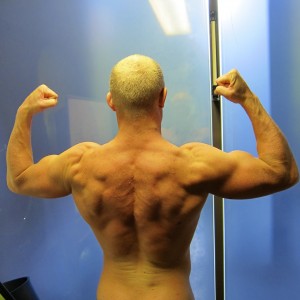To those of you who have been following my writing, for the second time this year thank you and again my apologies for the delay. There’s been quite a break, however for me this has meant a plethora of different experiences that I can now share with you.
Varying your Training
In February this year I was approached by a friend Scott at the gym where I run my business asking me to train him for a specific event that was taking place at the end of April, Men’s Fitness Magazine’s “Fit Bloke Challenge 2012″. I’m going to tell you a little about this training and how it resulted in building a strong and muscular back.
The above mentioned challenge is a cross fit based event and whilst I had not to this stage trained someone for such a discipline I based my training on a couple of years of my own training with a friend “Steve” who introduced me to some colourful titles for workouts such as “Fran” “Kelly” “Angie” “Jason” and “Annie”. A few years back, 2009 to be precise these names epitomized only one thing for me “pain” in the true sense but with a happy ending because what it did was introduce me to what I know now as a part of cross fit training and yes it also helped together with conventional strength training strip off body fat.
So in my own little world of training experience I had started to mix lifts such as Hang Cleans, Clean and Jerks, Push Presses, dumbbell and kettlebell swings, with all the bread and butter exercises such as bench presses bent over rows, deadlifts, squats, lunges, overhead presses, bodyweight push-ups, pull-ups, dips and isolation arm exercises including curls and french presses.
Advantages of including Olympic lifts
As I alluded to above one of the advantages of mixing up cross fit training with conventional weight training is that the power or lets call them olympic inspired lifts (which form a big part of cross fit) are great compound movements which involve the whole body, elevating your heart rate helping you burn off excess body fat, which to me is fun (painful though) and an alternate to doing cardio. Other advantages of this type of training are as follows:
- Provides variety to your routines giving that extra stimulus to the neuromuscular system
- The olympic lifts help you strengthen your core and aid in functional movement as you perform them standing on your feet.
- Coupled with conventional lifts the olympic lifts increase your strength, speed, acceleration, power, coordination, and improve your posture helping you stand tall.
- The combination also provides great sports specific training as they simulate prized movement skills for many team oriented sports, rugby in particular embraces this in their training programs.
The Program
In broad terms I prepared a 12 week macro periodisation cycle which was broken down into three 4 week mesocycles containing strength, hypertrophy, power, endurance, and pre-competition specific phases (speed). Compound exercises including the Deadlift, Front/Back Squats, Bench Press, and Over head Presses were the mainstays of the strength component which we did for the first 10 minute period of each workout followed by a cross fit inspired or in the parlance for this type of training the WOD (workout of the day) consisting of 21, 15, 9 or 30, 20, 10 rep count respectively over 3 exercises by 2-3 rounds, sprints and runs where also included ranging from 200 meters to 800 metres which were timed and recorded, to be bettered on the next occasion. The last 4 week mesocycle being the pre-competition phase saw the introduction of timed sessions we used a minute per exercise with the aim of completing as many reps as possible (amrap).
A sample workout from Phase 2 was as follows:
| Goal | Exercise | Sets/Rounds | Volume/ Reps | Intensity |
| Strength | Deadlift | 5 | 2-6 | 120kg-180kg |
| Power / Endurance | Box Jumps(Height 60cm) | 3 sets x 2 | 21, 15, 9 | |
| Strength/Endurance | Clean&Jerk(Thruster) | 3 sets x 2 | 21,15, 9 | 30kg-50kg |
| Strength/Hypertrophy | Pull-ups | 3 sets x 2 | 21, 15, 9 | Bodyweight |
| Speed/ Endurance | SprintsTreadmill | 3 sets x 2 | 200 metres | Levels 15 -19 |
The Results
Now we are getting to why I called this article “Building Your Back”. A couple of exercises that I used consistently throughout the12 weeks period were the pull-up and the chin-up, not only because I thought (and now even more so) these moves are the best back builders but also as I suspected and I was correct, they or a variation there of featured prominently in the challenge.
At about the midway point of the 12 week program I could see what affect all the pull-ups and chin-ups were having on Scott’s physique and overall strength and with his permission I have included a few photos that clearly show this development, the top one was taken in February and the other in April 2012, take particular notice of the striations in his lower trapezius.
As the earlier photo shows Scott was a very fit and strong athlete before he started the program however a completely different training regime to what he’d been doing took him to another level, don’t get me wrong though it doesn’t just happen he worked extremely hard the whole 12 weeks.
To summarise my overall message is once you have reached an advanced level with your conventional weights training and you feel you need to do something different try mixing in some different exercises like the olympic lifts or forms of training such as crossfit, or simply start some of your sessions with some of these lifts for a full body neuromuscular awakening. I know how difficult they are but keep working on those pull-ups and chin ups (assisted machines are a great starter) as these exercises are one of the best ways to building your back also great arms and shoulders to boot.
Make sure that you exercise safely, and as always I recommend that you seek the assistance of a personal trainer to help you with the fundamentals of some of the lifts mentioned above. Most of them are full body movements that need to be broken down into their respective component drills before they can be performed safely and effectively.
Zol
Fitness Moves


